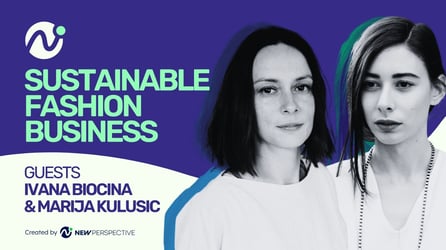ICPG's Journey Towards Sustainable Packaging
As plastic waste gains unprecedented visibility, captivating consumer attention and precipitating bans on specific packaging formats such as bags and straws, leading brands find themselves compelled to holistically consider their product life cycles and the post-consumer phase.
With a resolute focus on diverting these items away from landfills, ICPG is pioneering a transformative shift towards a more circular economy for plastic packaging solutions.
In this conversation, Jonathan Cage, Director of Business Development; Michael Moren, Commercial Director; and Natalie MacVarish, Director of Marketing at ICPG, bring to the forefront the critical importance of recyclable packaging and expand on the company’s forward-thinking strategy towards sustainability.
Follow ICPG online:
- Web icpg.co
- LI @icpgco
- IG @icpgco
- Crazy About Packaging Podcast icpg.co/podcast
Watch the episode on YouTube
Packaging industry problems: Navigating complexities and crafting solutions
Dunja Jovanovic: I wanted to start by asking you about the problems with the plastic industry and plastic pollution. I know that you have a lot of experience in this area, so I'm really interested to hear your thoughts on the challenges that the industry is facing.
Mike Moren: Sustainability is paramount in the recyclable packaging industry. Our clients, mainly consumer packaged goods companies and major converters in the global packaging arena, have made significant commitments to transition to recyclable packaging for their primary food products.
At ICPG, our expertise lies in understanding products, applications, and processing techniques used in packaging perishable goods. We're dedicated to creating sustainable packaging solutions that can be effectively recycled within the United States waste stream.
DJ: Can you shed light on the growing pressure that companies face to enhance the sustainability of their single-use packaging?
Natalie MacVarish: Over the past 5 to 10 years, there has been an immense consumer-driven push for companies to improve the sustainability of their single-use plastic packaging. Plastic waste, being highly visible, tends to stand out in the minds of consumers. In response, we've seen bans on certain plastic products like bags and straws, prompting brands to focus on end-of-life solutions for their packaging.
The goal is to divert these materials away from landfills and move towards a more circular economy for plastic packaging solutions.
Pioneering breakthroughs: Packaging innovations and alternatives
DJ: Can you outline the range of offerings that ICPG provides to its clients within the food packaging sector?
Jonathan Cage: We have a unique position as a material-agnostic company. We manufacture various materials such as polypropylene, polyethylene, and others, which can be tailored for different packaging needs, including thermal forming and full-seal applications.
What sets us apart is our ability to leverage this diverse portfolio to develop innovative and sustainable packaging solutions. For instance, we've been successful in designing alternatives to polystyrene, a material facing significant pressure due to regulatory concerns. Through modifications and innovations, we've created a recyclable, economically viable solution that meets both performance and sustainability goals.
DJ: Could you share some examples of successful collaborations where ICPG has helped companies upgrade their packaging solutions?
NM: We've been collaborating with companies worldwide, conducting trials on six continents. This widespread engagement underscores the demand for solutions like ours, especially as we address the challenges of transitioning away from polystyrene.
Our approach takes into account the existing equipment and infrastructure of these companies, ensuring that our solutions can seamlessly integrate. For instance, in the realm of yogurt multi-packs and single-serve condiments, our materials maintain the desired product functionalities while offering recyclability, meeting both consumer expectations and business needs.
DJ: Jonathan, can you provide more insights into your innovative approach to replacing polystyrene and your commitment to recyclability?
JC: Our innovative material Polypropylene, is designed to effectively replace polystyrene in various applications, such as form-fill-seal packaging. We've engineered this material to replicate the performance attributes of polystyrene while being fully recyclable and devoid of additives or compounds.
Our development has been guided by a deep understanding of the industry, application requirements, and performance expectations. We've aimed to create a sustainable solution that not only aligns with the industry's push for recyclability but also maintains product quality and functional integrity.
DJ: As we discuss recyclability, could you elaborate on the importance of volume and market demand for the successful recycling of materials like Polypropylene?
NM: The existing usage of polypropylene in various applications, including thermal form products, provides a foundation for successful recycling efforts. With an established volume of polypropylene materials already in circulation, our solution seamlessly integrates into existing recycling systems, making it economically viable and environmentally effective. Our approach taps into this existing infrastructure, ensuring that our sustainable solutions have a viable path within the recycling ecosystem.
DJ: Mike, you mentioned the crucial interplay between material supply and demand for successful recycling. Could you elaborate on this relationship and how it impacts your industry?
MM: It's a two-way dynamic. On one hand, you need a substantial supply of material to make recycling viable, but at the same time, there must be a growing demand for recycled material. Currently, the material we're targeting to replace, namely polystyrene, is experiencing a decline in demand.
Over the past 15 years, the demand for polystyrene has been shrinking, and there isn't significant investment going into producing more of it. Conversely, we're witnessing a substantial influx of investment in producing additional polypropylene, as Jonathan mentioned earlier.
Cleantech marketing challenges: Building brand identity and empowering consumers
DJ: Shifting gears a bit, let's talk about your brand story. Jonathan, could you recount the early stages of Icpg's brand identity and what you aimed to establish?
JC: About five years ago our focus was on creating synergies and expanding our product portfolio. This expansion included not only our legacy products like polypropylene and polystyrene but also introducing multi-layer and multi-material structures. This evolution culminated in the development of our innovative XPP platform.
DJ: What challenges did you encounter during this process of establishing your brand identity?
MM: Despite having a wealth of industry experience, our brand was new, and we needed to overcome that unfamiliarity. Establishing brand recognition was crucial for us. This involved developing a comprehensive brand and go-to-market strategy, hiring a team, setting up the necessary infrastructure, and, of course, spreading awareness about who we are and what we offer. One of our core challenges was overcoming this initial obscurity.
DJ: Education is often crucial when introducing an innovative product. Natalie, how did you approach educating both potential clients and consumers about your solution?
NM: Educating our target audience was essential, especially given the innovative nature of our product. We collaborated with machinery and technology platform developers to create samples that demonstrated our solution's capabilities.
This provided tangible proof of concept that resonated with potential clients. Additionally, our participation in industry events, such as conferences and podcasts, helped us share our knowledge and expertise. By focusing on both direct engagement and strategic partnerships, we effectively educated clients and consumers about our product.
DJ: Could you delve into the specific marketing initiatives you undertook to enhance brand awareness?
NM: Once we identified our niche, particularly in replacing polystyrene for form-fill-seal applications, we honed in on precisely who we wanted to target. Our approach combined inbound and outbound marketing techniques. We focused on platforms like LinkedIn, leveraging advertising campaigns and account-based marketing.
We utilized email marketing and attended carefully selected trade shows, which were tailored to our specific industry sector. One of our strategies was to be bold and direct in our messaging. We highlighted the ways in which our solution was superior to polystyrene, taking a straightforward approach to communicating our competitive edge.
Company advancements and sustainable packaging industry insights
DJ: Are there any recent developments or news you can share about ICPG or the barrier food packaging sector?
MM: We're actively collaborating with organizations like PureCycle to qualify our materials, obtain certification or pre-certification for recyclability, and secure PCR (Post-Consumer Recycled) feedstock. This feedstock integration is crucial for incorporating recycled content into our product development process.
NM: Within our larger organization, we're currently expanding our facilities and adding new equipment to increase capacity.
JC: I'd like to add that our Reba product is a significant development. It takes our existing XPP solution and elevates it to offer enhanced barrier properties, providing extended shelf life and improved performance without the use of traditional barrier solutions like EVOH or PVDC. Additionally, we're launching an innovative group of products that expand our capabilities in barrier packaging, opening up new possibilities for applications in modified atmosphere packaging.
DJ: Mike, with your extensive industry experience, what advice would you offer to newcomers in the industry who are navigating similar challenges?
MM: My advice is to always start with a deep understanding of your "why." Whether it's for the community, the environment, or cost savings, let your motivations guide your actions. Keeping your purpose at the forefront will help steer your decisions and strategies.
Find us on podcasting platforms:
Follow us on social media:



